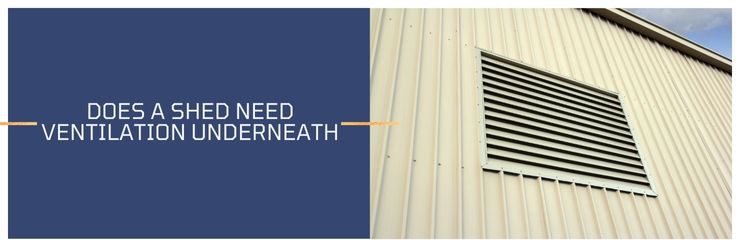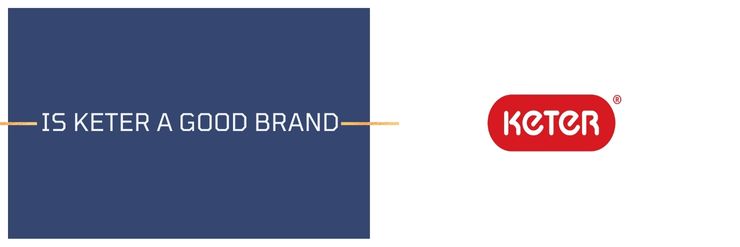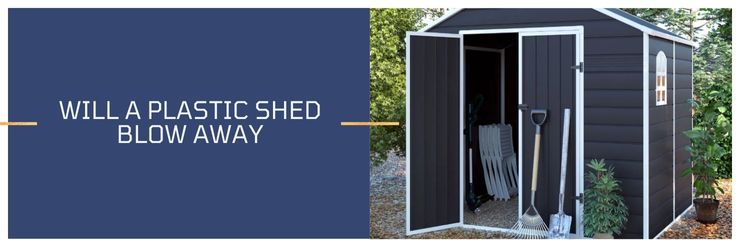A lot of people seem to be wondering if it’s okay to sit a shed on grass. People are worried that the weight of the shed might damage the lawn, or that the shed might sink into the ground over time. After all, it seems a like a hell of a lot of effort to build a concrete foundation for a shed just to store some tools in it. So, can a shed sit on grass?
Placing a shed directly on grass will damage the shed over time. Problems with moisture damage, rot, rust, and even structural damage may occur if left on the grass. A better solution is a gravel foundation or raising off the ground on a base. A concrete foundation is ideal for large, heavy sheds.
If you are loking for answers to your shed placement problem then you have come to the right place. We will look at what sheds are ok on the ground and what type of foundation or base is best suited for your shed.
Can A Shed Sit On Grass
It is never a good idea to place any shed directly on grass. The bottom of the shed will rot away quickly if it is in direct contact with the ground. It is much better to build a small wooden platform for the shed to sit on, or to place the shed on concrete blocks. This will keep the bottom of the shed dry and protected from the rotting effects of moisture.
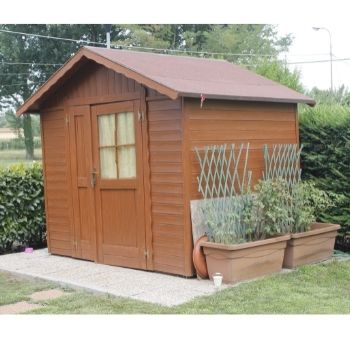
Another problem that can occur when a shed is placed on grass is that the weight of the shed can sink into the ground, causing the shed to become unlevel. This can cause the doors and windows to not open and close properly, and can also damage the shed itself. If you must place your shed on grass, be sure to level it out as much as possible to avoid these problems.
Whether you have a wooden, vinyl or metal shed, I would always place it on either a foundation or on a raised base.
What about Wood, plastic/resin, and metal sheds, can they sit on the grass – Let’s ask the experts
In nearly all cases, placing your shed on some sort of raised platform with proper drainage will better protect it and increase its lifespan. Unless you have a large shed, you don’t need to go digging up your backyard and pouring concrete, there are other, much more affordable, and suitable options available.
But, don’t take my word for it, let’s ask some experts!
To get a better answer, I thought it would be wise to speak with some of the most popular shed brands out on the market today and see what their requirements are on placing a shed directly on grass.
in summary, this is what they said:
| Material | Brand | sit on grass | Sit on a base/ Foundation |
|---|---|---|---|
| Plastic | Rubbermaid | No | Yes |
| Plastic | Suncast | No | Yes |
| Plastic | Lifetime | No | Yes |
| Plastic | Palram | No | Yes |
| Wood | Tuff Shed | No (already have a base and floor) | Yes |
| Wood | Handy Home | No (already have a base and floor) | Yes |
| Wood | forest garden | No | Yes |
| Metal | Arrow | Can but not recommended | Yes |
| Metal | Outsunny | Yes | Yes |
| Metal | Bosmere | Yes | Yes |
| Metal | Hanover | No | Yes |
As you can see, all the brands we asked, for said they recommend placing your shed on either a concrete foundation or a wooden base. Even the ones who suggested placing the shed directly on grass all continued by saying a base or foundation would be the best option in protecting the shed.
Another recommendation, one that is often overlooked is the overhang of a shed, find out more about does a shed roof need an overhang here
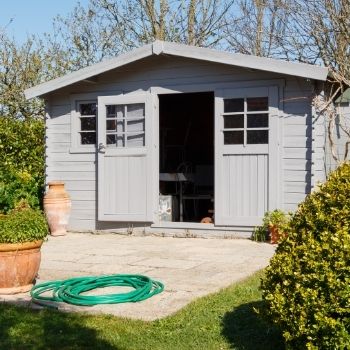
It’s easy to understand the argument for wood not being allowed to directly sit on the grass. Even if the wood has been treated to prevent rot and damage it will surrcome to the environment in only a few years.
Wet and frost from the ground will slowly start to rot the wooden beams while the whole structure will start to warp as the ground swells and changes altering the structural integrity of the shed to the point where even opening the door will become a chore.
Plastic and metal sheds will also suffer a similar fate.
Metal sheds will start to rust straight away, even if the metal is treated it will show signs. Eventually, the whole bottom floor of the shed will be badly rusted out.
Plastic will probably last a little longer than wooden or metal sheds as they wont rot or rust but they can’t stop the ground from swelling and changing. The weight of the shed, like with a wooden and metal sheds will also warp over time and will slowly start to sink into the ground. This may take a few months to even years but it will happen and it will permanently damage your shed.

If you just place your shed directly on grass eventually the material will deteriorate, the shed will warp and twist out of shape and it will sink into the ground in only a few years. Some sheds have a 10, 30, or 50-year warranty against damage but placing it directly on grass would be a death sentence and would likely invalidate your warranty.
By simply investing in a foundation or base that will raise the shed out of the damp conditions, will help keep the shed in a good state for years to come. Even something as simple as placing a few paving slabs on the grass will help a lot.
Related article:
What Type of Foundation Is Best for Your Shed
A gravel foundation would be ideal for small to medium-sized sheds. Gravel foundations are excellent for drainage. Concrete is preferable for big, heavier sheds, especially those without a pre-existent floor. Consider placing small to medium-sized sheds on pressure-treated lumber too.
Excessive moisture on your shed’s foundation will cause premature decay and rot, so you will want to make sure to get the best foundation for your shed.
Picking the right foundation can be tricky, as it may depend on your shed’s size, location in your yard, and the building permits required for certain foundations. Explore the best shed foundations in our comprehensive table gallery below:
| Foundation / Base | Added info |
|---|---|
| Concrete Slab or Concrete Pavers | Best Option for Most Sheds, Solid Foundation Protected from Excessive Moisture, Easy to Install, Inexpensive Base Foundation Option |
| Skid Foundation | Easy to Install with Fast Results, Impermanent Design for Easy Transportation, Close to Ground Surface, Great for Sheds of All Shapes and Size |
| Plastic Paver System | Innovative Design, Great for Battling Excessive Moisture, Great for Sheds of All Shapes and Sizes, Easily Transportable, Easy and Fast Installation Proces |
| Lumbar Frame with Metal Bracing | Great Protection Against Moisture, Provides Level Base, Lifts Base from Harmful Moisture, Provides Ventilation Under Shed, Long-Lasting Brace Option with Increased Performance |
| Adjustable Screw Piles | Suitable for Any Soil Condition, Great for Frost Protection, Works with Any Size Shed, Quick Installation, Slightly More Difficult to Execute for Novice Shed Owners |
| Concrete Piers and Beam Foundation | Concrete Piers and Beam Foundation Offers Best Protection, Extends Life of Shed By Decades, Great Permanent Structure Option, Difficult to Construct, Best for Large or Industrial Sized Sheds |
| Gravel foundation | Gravel is an excellent foundation because it can be leveled and provide excellent drainage. It’s also not uncommon to have a lumber frame base on top of the gravel. |
There are many available options to explore, so do some research and find the option that suits you best. You can explore which one of these options is best suited for your needs below.
Which Foundation Type Should You Use for Your Shed
With so many different foundation bases to choose from, it may be difficult to decide which foundation type will be best for your shed. You can find a more detailed description of each foundation type below.
- Concrete Slab or Concrete Pavers – Concrete is an incredible tool that you can use to provide a solid foundation for your shed. Pavers are easy to install and require minimal planning and expenses. A solid concrete foundation requires a little more planning, but it will provide a moisture-proof seal for your shed’s floor. Concrete slabs and pavers still may encounter structural damage from stubborn roots or tectonic shifting. Alternatively, you can use concrete deck blocks to provide a raised lumber platform for your shed to sit on, protected from the moisture of the soil.
- Skid Foundation – A skid foundation is an inexpensive and practical way to support your shed and protect it from damp conditions that will cause your shed’s floor to rot. A skid foundation uses pressure treated 4×4 wooden lumber or skids. Larger sheds will make use of 4×6 or 6×6 skids, this will not only protect your shed by raising it off the ground but will make your shed easily transportable so you can save time when moving to a different geographical location. Skid foundations are still prone to sinking, though, and a more permanent structure is suggested for the best results.
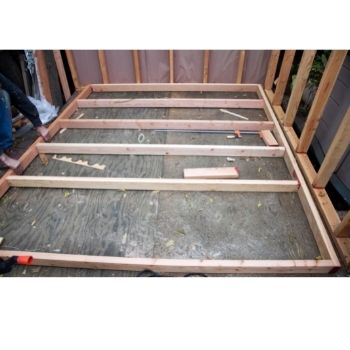
- Plastic Paver System – This is a great way to restructure a garden or make the use of extra gravel you may have. Plastic paver systems have all the benefits of a skid foundation, but better. A plastic paver base with loose gravel will encourage the best drainage and ensure that no excess moisture will rot the wooden structure of your shed.
- Lumbar Frame with Metal Bracing – This is just one step up from a lumbar base with concrete deck blocks, as you are able to provide a lifted level surface that will be protected from excess moisture. Metal bracing will be able to stand up against the test of time and provide a more adaptable structure that protects the floor of your shed from harsh weather conditions. The metal bracings are mostly used in addition to a concrete slab, so this is a good way to upgrade your current foundation system.
- Adjustable Screw Piles – This system is a lot similar to the metal bracing structure but offers a little more adaptability as far as length goes. Each one of these screw piles has adjustable lengths, so this will be best used for a shed that has an unlevel ground surface.
- Concrete Pillars and Beam Foundation – This system is best used for large or industrial type sheds, and it provides the most protection against the elements. Your shed foundation will be frostproof and lifted at a higher level to combat moisture and promote proper drainage. This is the most complex system, and you might need the help of professionals to properly incorporate this model.
- A Gravel Foundation For a Shed – This is a 4-inch layer of gravel that is spread over the area where you want to place your shed. This layer provides a solid, level foundation for your shed. It also provides excellent drainage to keep your shed dry and free from moisture. A gravel foundation is one of the easiest and most economical foundations to build for a shed.
What Is an improper Proper Shed Foundation
Though it may seem that a shed will hold up directly on the ground to novice yard strategists, an experienced shed owner will know the dangers of an improper foundation. Building a shed directly on the ground is not a good way to ensure your shed’s health for many reasons. Take a look at a few issues you may encounter if you decide to build your shed with no foundation on the grass.
- Improper Surface Level – One of the most important things to consider when building a shed is providing a level floor surface to maintain the function of your doors. Geographical locations under sea level may be prone to sinkholes, so you want to make sure that you raise your shed at a proper level to maintain functional entryways.
- Improper Moisture Levels – When your shed’s wood is introduced to a damp surface such as grass for an extended period of time, it will absorb the excess moisture and rot a lot faster than normal. Maintain your shed properly with a solid foundation to prevent your wood from premature decay.
- Improper Water Drainage – Another powerful weather component that affects rot and decay is water drainage. With no foundation, a wooden floor will have to succumb to an excess amount of moisture when it rains. Too much frequent moisture caused by improper drainage can lead to rot and decrease the longevity of your shed’s life.
- Improper Ventilation – If your shed is placed directly onto the grass, it may be subject to improper ventilation. Improper ventilation can lead to toxic chemicals that will invade your workstation and cling to your personal belongings. Proper ventilation underneath your shed will provide the best airflow and prevent mildew or rot on your shed’s foundation.
- Unstable Base – If you have a medium or large shed and try to cut corners by investing in the cheapest base possible, you may be causing more harm than good. A shed that has a lawn, gravel, or dirt base will be unstable and your shed may warp, rot, or have irreparable structural damage.
As you can tell, there are many ways that an improper foundation can impair the overall health of your shed and shorten the length of its usage.
The bigger your shed is, the more likely you will need expensive permits and professional construction to make it secure and ready for extended usage. Finding the right base for your shed is pertinent to its survival, and there are many inexpensive base options out there.
Final Thoughts
So, Can A Shed Sit On Grass? It may seem like the easiest route to just put your shed directly in your yard, but the excess moisture of the grass and improper drainage will eventually lead your shed to rot. Take care of your personal belongings and workspace by providing a stable base.
Finding the right shed foundation will enhance the longevity of your shed’s life by decades. Do not risk the safety of your shed. Instead, invest in a shed base that will last a lifetime.




